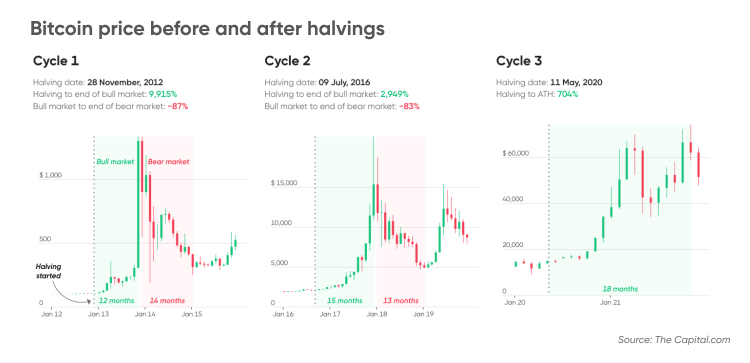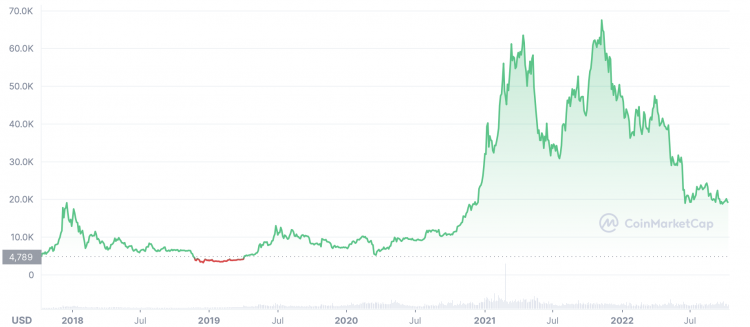
Bitcoin (BTC) has made something of a recovery after a disastrous 2022, breaking above the $30,000 mark for a time in April 2023.
Market observers had to recalibrate their expectations last year– some had predicted that the coin was on its way to $100,000, a bitcoin price target that now seems incredibly optimistic – with many forecasters lowering their bitcoin projected values, at least in the short term, but things are now looking somewhat more positive.
With BTC sank to a low of $15,682.69 on 9 November after the collapse of the FTX (FTT) exchange rocked the crypto market, recovering to a high of $18,054.31 the following day and then falling again to around $16,850, the value of bitcoin remains far below its all-time high of $68,789.63, reached in November 2021. Despite a sustained rally over $17,000 in early December, it was below that figure on 12 December 2022.What has driven the volatility in the bitcoin price, and what are the latest bitcoin projections as of 18 April 2022? Let’s take a look.
How does bitcoin work?
Bitcoin is a decentralised digital currency that was created in 2008 by an anonymous developer going by the name Satoshi Nakamoto. Bitcoin is mined and distributed on a peer-to-peer digital ledger called a blockchain, which uses cryptography to validate and process transactions.
Bitcoin was officially launched in January 2009 when the first block, known as the genesis block, was mined on the blockchain.
Each new block contains a proof-of-work (PoW) protocol to be accepted by the network – miners use computer processing power to verify the cryptographic hashes in each block. As a reward for mining a new block, miners receive transaction fees from the block as well as a set number of newly generated bitcoins (BTC).
Bitcoin was designed to have a maximum circulating supply of 21 million coins, with the mining reward of new coins reduced by half after every 210,000 blocks are mined, in an event known as the “halving”. The most recent halving occurred on 11 May 2020, reducing the block reward to 6.25 BTC. The next halving will take place in 2024.
On 12 December 2022 there were a little over 19.2 million bitcoin in circulation. With the halving events reducing the creation of new coins, it is expected to take until 2140 before the full 21 million BTC are in circulation.
Bitcoin price history
Let’s now take a look at some of the bitcoin price history. While past performance should never be taken as an indicator of future results, knowing what the coin has done over the past few years can help give us some much needed context if we want to either make our own BTC price prediction, or interpret one that is already out there.
The capped supply aims to maintain bitcoin’s scarcity, increasing its value over time as an inflationary asset, as usage increases while availability remains fixed. The bitcoin price has soared around the time of previous halvings, jumping from $12 at the time of the first halving in November 2012 to over $1,000 a year later, and climbing from $650 at the time of the second halving in July 2016 to $20,000 in December 2017.
Following the 2020 halving, the BTC price soared from around $9,000 to the November 2021 peak.

Given bitcoin’s inflationary nature, it became popular among retail investors as a form of “digital gold”. It was viewed as a safe haven asset offering portfolio diversification and a hedge against falling prices for other financial assets such as stocks and bonds.
But as more investors have entered the market and involvement from institutional investors has grown, bitcoin has gradually become more correlated to stock markets.
The 2017 cryptocurrency rally saw the bitcoin price soar from around $1,000 at the start of the year to a new high of $20,000 in mid-December of that year. A sharp sell-off in 2018 pulled the BTC price down to $8,000 in little more than a month, and below $4,000 by the end of the year.
Bitcoin peaked at $13,129.53 in July 2019, but it was in 2020, after an initial sell-off across most financial assets in March, that the BTC price took off. With the halving in May 2020 and rising interest from investors, bitcoin ended the year at $29,000 and continued to rally in 2021.
Bitcoin soared above $64,000 in mid-April 2021, leading a surge across the growing number of altcoins, or alternative cryptocurrencies. The price fell to a low of $29,360.96 on 20 July 2021, then began to rebound over the summer on its way to the all-time high in November.But profit taking and mass sell-offs gave way to a new bear market at the end of last year, with bitcoin plunging to $46,000 at the end of December 2021.

How did bitcoin perform in 2022?
The decline continued and the bitcoin price dropped to $33,184.06 on 24 January 2022. The market attempted to recover, rising to $45,661.17 on 10 February, but retreated to $34,459.22 just two weeks later following Russia’s invasion of Ukraine. Bitcoin bounced back to $48,086.84 on 28 March 2022, but it was unable to hold on to the gains.
The bitcoin price dropped to a low of $26,350.49 on 12 May 2022, the day when the US dollar index reached a then-20-year high and the terra cryptocurrency crashed, driving bearish sentiment and prompting investors to withdraw their funds from cryptocurrencies into dollars.
Bitcoin briefly traded above $31,000 heading into June as the market responded to the terra collapse, but another rapid sell-off brought the price down to $17,708.62 on 18 June. The price has since bounced above $20,000 three times before dropping back, reaching $24,196.82 on 20 July 2022.
The cryptocurrency markets are being buffeted by several external as well as internal factors. The collapse of the terraUSD stablecoin and LUNA token was followed by the bankruptcy of the Three Arrows Capital cryptocurrency hedge fund at the end of June.
The cryptocurrency broker Voyager Digital, which had lent funds to Three Arrows, filed for its own Chapter 11 restructuring on 5 July 2022. On 13 July, the cryptocurrency lending platform Celsius Network filed for Chapter 11.
The contagion continued to spread, as Singapore-based Zipmex halted withdrawals from 20 July until 22 July, a move that also preceded the bankruptcies of Voyager and Celsius, as well as Vauld, another Singapore-based platform that filed for restructuring on 8 July after suspending withdrawals four days earlier.
Bitcoin dropped below $23,000 on 21 July 2022 after the electric vehicle maker Tesla said in its second-quarter financial report that it had liquidated 75% of its BTC purchase holdings during the quarter for $936m in cash. Tesla’s CEO, Elon Musk, said on the company’s earnings call:
“The reason we sold a bunch of our bitcoin holdings was that we were uncertain as to when the Covid lockdowns in China would alleviate. So, it was important for us to maximise our cash position, given the uncertainty of the Covid lockdowns in China. We are certainly open to increasing our bitcoin holdings in future, so this should not be taken as some verdict on bitcoin. It’s just that we were concerned about overall liquidity for the company.”
After that, the coin struggled. On 11 October 2022 it was worth a little over $19,000, giving it a market cap of about $366bn. Although it recovered to $21,446.89 on 5 November, news of Binance pulling out of the takeover of the FTX exchange caused a market collapse which was made worse when FTX filed for bankruptcy on 11 November. Around this time, BTC was hovering around $16,000, with a periodic low of $15,834.02 on 10 November. Bitcoin was able to make something of a recovery at the end of November, rising above $17,000 to hit a periodic high of $17,378.15 on 5 December. The coin closed the year at $16,547.50, more than 60% down year-on-year. By contrast, the S&P 500 Index (US500) of…
Read More:Bitcoin Price Prediction | Is Bitcoin a Good Investment?


